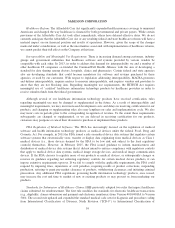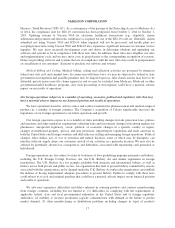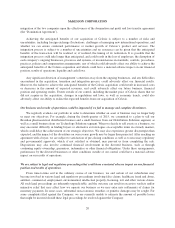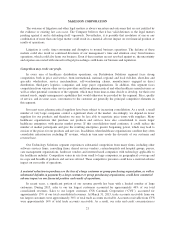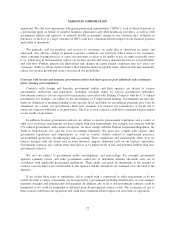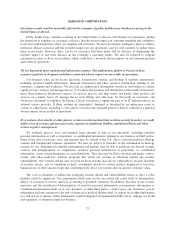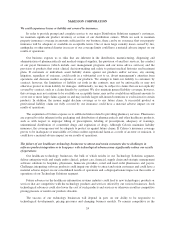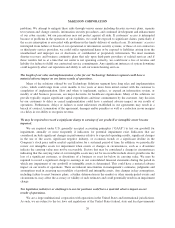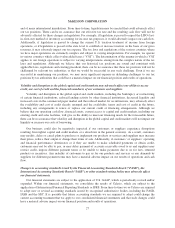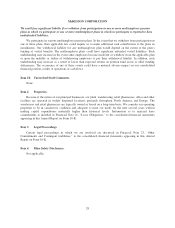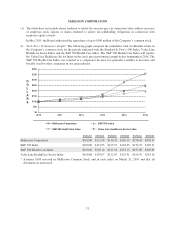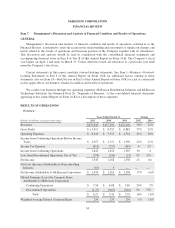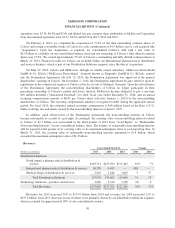McKesson 2015 Annual Report Download - page 31
Download and view the complete annual report
Please find page 31 of the 2015 McKesson annual report below. You can navigate through the pages in the report by either clicking on the pages listed below, or by using the keyword search tool below to find specific information within the annual report.McKESSON CORPORATION
problems. We attempt to mitigate these risks through various means including disaster recovery plans, separate
test systems and change controls, information security procedures, and continued development and enhancement
of our cyber security, but our precautions may not protect against all risks. If customers’ access is interrupted
because of problems in the operation of our facilities, we could be exposed to significant claims, particularly if
the access interruption is associated with problems in the timely delivery of medical care. If customers’ access is
interrupted from failure or breach of our operational or information security systems, or those of our contractors
or third party service providers, we could suffer reputational harm or be exposed to liabilities arising from the
unauthorized and improper use or disclosure of confidential or proprietary information. We must maintain
disaster recovery and business continuity plans that rely upon third-party providers of related services and if
those vendors fail us at a time that our center is not operating correctly, we could incur a loss of revenue and
liability for failure to fulfill our contractual service commitments. Any significant instances of system downtime
could negatively affect our reputation and ability to sell our remote hosting services.
The length of our sales and implementation cycles for our Technology Solutions segment could have a
material adverse impact on our future results of operations.
Many of the solutions offered by our Technology Solutions segment have long sales and implementation
cycles, which could range from a few months to two years or more from initial contact with the customer to
completion of implementation. How and when to implement, replace, or expand an information system, or
modify or add business processes, are major decisions for healthcare organizations. Many of the solutions we
provide typically require significant capital expenditures and time commitments by the customer. Any decision
by our customers to delay or cancel implementation could have a material adverse impact on our results of
operations. Furthermore, delays or failures to meet milestones established in our agreements may result in a
breach of contract, termination of the agreement, damages and/or penalties as well as a reduction in our margins
or a delay in our ability to recognize revenue.
We may be required to record a significant charge to earnings if our goodwill or intangible assets become
impaired.
We are required under U.S. generally accepted accounting principles (“GAAP”) to test our goodwill for
impairment, annually or more frequently if indicators for potential impairment exist. Indicators that are
considered include significant changes in performance relative to expected operating results, significant changes
in the use of the assets, significant negative industry, or economic trends or a significant decline in the
Company’s stock price and/or market capitalization for a sustained period of time. In addition, we periodically
review our intangible assets for impairment when events or changes in circumstances, such as a divestiture
indicate the carrying value may not be recoverable. Factors that may be considered a change in circumstances
indicating that the carrying value of our intangible assets may not be recoverable include slower growth rates the
loss of a significant customer, or divestiture of a business or asset for below its carrying value. We may be
required to record a significant charge to earnings in our consolidated financial statements during the period in
which any impairment of our goodwill or intangible assets is determined. This could have a material adverse
impact on our results of operations. There are inherent uncertainties in management’s estimates, judgments and
assumptions used in assessing recoverability of goodwill and intangible assets. Any changes in key assumptions,
including failure to meet business plans, a further deterioration in the market or other unanticipated events and
circumstances, may affect the accuracy or validity of such estimates and could potentially result in an impairment
charge.
Tax legislation initiatives or challenges to our tax positions could have a material adverse impact on our
results of operations.
We are a large multinational corporation with operations in the United States and international jurisdictions.
As such, we are subject to the tax laws and regulations of the United States federal, state and local governments
26


